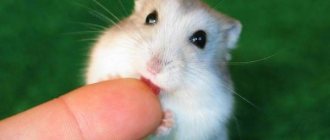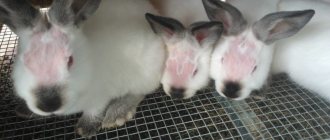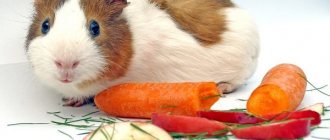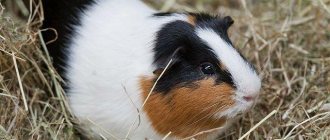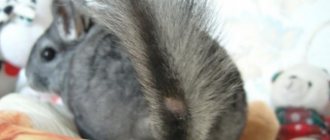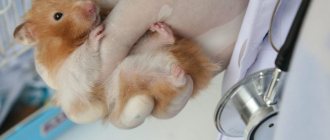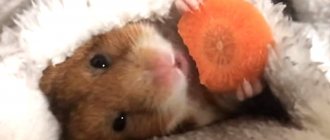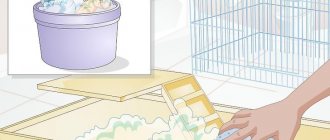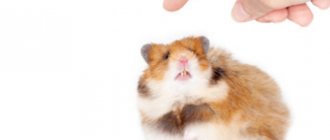Very often in my practice I came across a situation where parents tried to buy a rabbit from me for their children. Like, like a child’s first animal.
Or not the first. Anything happened.
Another question: “Is it necessary?!” Still, a child and a rabbit are a controversial topic...
Classification
All decorative rabbits are divided into several subcategories, according to which it is easy to choose the animal you like.
By size they are divided into:
- small;
- average;
- large.
According to the length of the coat there are:
- short-haired;
- normal-haired;
- long-haired.
Let's look at the most popular breeds for home keeping, their characteristics, care features and interesting facts.
About puberty
Beginning rabbit breeders who plan to breed these furry animals are interested in the question of when the animal can bear offspring. By the following signs you can easily determine the puberty of a fluffy:
- the rabbit is overly active and quite aggressive,
- stops going to the litter box and leaves his excrement wherever he pleases,
- begins to dig the floor or bottom of the cage,
- marks territory
- the female begins to pull out her down and arrange a place for offspring,
- both males and females begin to pester everyone around, from other pets to the owners.
As soon as the furry pet begins to show such habits, it can be “knitted” to produce offspring.
Dutch Fold
Origin story.
The breed was developed in Holland around the 1950s. But it was registered only 47 years later in Austria.
Characteristic.
A distinctive feature of the Dutch Fold rabbit is its ears hanging down . Their length is 24-28 cm. But attention: ideal representatives of the breed should not have ears dragging along the ground!
- The ears of a Dutch Fold rabbit do not become floppy immediately, but only 5-10 weeks after birth.
- Average weight is up to 2 kg, occasionally exceeding 3 kg.
- Acceptable colors are gray (sometimes with spots), sometimes with shades of purple or dark blue. But today you can often find both white and black Dutch rabbits.
Ear care.
The Dutch rabbit's ears need to be cleaned several times a week with a cotton swab. Once every six months - take him to the veterinarian for examination. Make sure that no pus appears inside, as this can lead to more serious consequences.
Carefully! You should not wash your Dutch rabbit's ears. The animal may lose its hearing!
How to determine the gender of a rabbit
It is necessary to gently press with your fingers on both sides of the genital organ. The male reproductive organ is located just beyond the anus. In females, the genital slit is located next to the anus.
Irina Ivanishchena
I am engaged in professional breeding of hamsters and rats on an ongoing basis. I know something about them that most people don’t know. Always open to constructive discussion
Post Views: 737
Dwarf butterfly
Origin story.
Dwarf butterflies are one of the oldest breeds of decorative rabbits. They were bred back in the 19th century in England. At that time they weighed up to 2.5 kg, but as a result of breeding work, their weight is currently about 1.8 kg.
Characteristic.
- Rabbit dwarf butterflies are not long-lived and, if well kept, live up to 7 years. Perfect for beginners who have never had such pets before.
- The breed has a distinctive feature - a special color . It is usually white. The animal has symmetrical spots on both sides, like a butterfly. And along the vertebra there is also a long black stripe.
Care.
Dwarf butterflies do not require special care. Like other rabbits, they need a good cage and a balanced diet. But, dwarf butterflies tend to become depressed if kept in isolation and alone. Therefore, they need frequent walks outside and communication with other animals.
It is best to have 2-3 dwarf butterflies.
Diseases
Common diseases
- VGBK;
- gastrointestinal stasis;
- urinary dermatitis;
- coccidiosis;
- myxomatosis;
- pasteurellosis.
If, during a period of heavy molting, a rabbit licks its own fur and the fur of a relative, then lumps of hair accumulate in the stomach. The result is bloating and constipation. There is a risk of intestinal blockage.
Rhinitis in rabbits: causes, symptoms, treatment methods
The main reasons are allergies, colds and infectious pathologies. Symptoms:
- swelling and redness of the nasal membrane;
- wheezing when breathing;
- the formation of crusts from dried secretions.
The animal constantly sneezes and scratches its nose.
Treatment uses drops that are instilled into the nasal passages. Medicines are prescribed by a veterinarian. Additionally, it is necessary to disinfect the rabbit corner.
Pasteurellosis in rabbits
The main symptom is an increase in general temperature to 40 degrees. The animal coughs, sneezes, and breathing becomes difficult.
Treatment uses injections. The medications are prescribed by a veterinarian.
Angora lion
Origin story.
Angora lions were bred more than 3 centuries ago in Turkey, in the city of Angora. The first rabbits in Europe appeared in France in the 18th century and quickly began to gain popularity in Russia. Initially they were used for fur, but today representatives of this breed are kept exclusively as pets.
Characteristic.
- Angora lions are small in size, weighing from 2 kg to 6 kg.
- For their oh-so-long fur, they are even listed in the Guinness Book of Records.
- The most popular colors are red and brown. But you can also often find white, gray, and even black Angora rabbits.
In addition to the Angora lion, there is another, more interesting breed of decorative rabbits - the Angora crocodile . But they are not often started in Russia.
Care.
The Angora lion's fur requires great care. Every 2-3 days, rabbits should be combed, otherwise tangles and lumps will appear that will have to be pulled out.
Plain food is not suitable for Angora lions. It is better to give a special one that contains a lot of fiber. It helps prevent the hair from matting.
Lesson summary for children of the senior group “Rabbits and Hares”
Irina Frolova
Lesson summary for children of the senior group “Rabbits and Hares”
consolidating and expanding children's knowledge about wild and domestic animals using the example of rabbits and hares.
to clarify children’s ideas about the life of hares in the forest, about the life of rabbits as pets.
Give an idea of wild rabbits, their habitats, and way of life. Show their differences from hares and domestic rabbits.
Clarify the signs of domestic and wild animals.
Paintings depicting a hare, domestic rabbits, steppe rabbit; toy hare
Children, today a hare came to our lesson to learn about the life of his relatives: among the toys there was a conversation that the guys would talk about hares and some rabbits today. “I know who hares are, but I’ve never even heard of rabbits,” says the bunny.
Please look at the picture and answer the questions:
Hares are herbivores.
Hares eat only plant foods: leaves, stems, roots, bark of young trees, fruits. They also eat mushrooms, but their favorite delicacy is aspen bark. For hares it is sweeter than sugar. Where there is an aspen tree fallen by the wind, the hares will gnaw the bark clean. The teeth of hares are suitable for this.
What can you say about cleft teeth?
The hare's teeth are large and flat - for feeding, not for attack. And the hind legs are much larger than the front ones.
Do hares have enemies and how do they escape from them?
A lot of them. These are foxes, wolves, magpies, crows, martens.
I immediately want to justify the hares. Everyone thinks they are cowards. But this is not so. A ten-day-old hare fights off a magpie or crow by standing on its hind legs, waving its front legs and screaming loudly to intimidate. In the same way, their mother protects them from feathered enemies. And if the enemy attacks from the air, the hare falls onto her back and tries to rip open the attacker’s belly with her hind legs. The fox and marten are distracted from the hares by running around and firmly beating their feet on the ground. Happens and dies saving children. So, it’s a shame for the hares, they were unfairly classed as cowards. And the fact that they, having heard a rustle, take off from their place and run away is not cowardice, but animal wisdom: it is stupid to stand still waiting to be eaten. There is a Russian proverb about this: “The hare is not a coward, he takes care of himself.”
Finger gymnastics “Bunny”
Hermelin
Origin story.
These animals were bred in the 19th century, but appeared in Russia only recently. The first Hermelins were brought to the Moscow exhibition of miniature rabbits in 1998.
Hermelina is often confused with its close relative, the Polish rabbit . Hermelins are rarely seen in Russia, but they are very popular in England.
Characteristic.
- The weight of these rabbits is about 1 kg.
- The color, according to the standards, is only pure white.
- The eyes must be either red or blue.
- Hermelines are short-haired (length - about 2 mm). The length of the ears is up to 7 cm.
Hermelin rabbits are also called stoats.
Care.
You can bathe your rabbit no more than once a year. During the molting period, be sure to comb once or twice a week. Since hermelins often suffer from obesity, it is very important to properly balance their diet and calculate portions by gram.
Meet the rabbit. Summary of an integrated lesson in the middle group
Elena Bratukhina
Meet the rabbit. Summary of an integrated lesson in the middle group
Integration of educational areas: “Cognition (formation of a holistic picture of the world)”, “Artistic creativity (drawing)”, “Communication”, “Health”, “Socialization”
Meet the rabbit.
give children an idea of a rabbit; teach to establish connections between the nature of the animal’s movement and the structure of its limbs; highlight the characteristic features of the appearance of a rabbit; form an idea of what the animal is fed and how it is cared for; learn to identify the conditions necessary for the life of a rabbit; activate vocabulary, thinking; develop an interest in animals; cultivate a desire to care for animals.
Methodical techniques:
- assistance in performing productive activities;
Materials : rabbit, toy bunny, rabbit food, paints, brushes No. 3, glue brushes, drawing paper.
Vocabulary work: rabbit, hare, hind legs, front legs, long-eared, long-legged.
Individual work : activate Anya and Arsenia in class;
Jumps deftly and gnaws carrots. (hare)
Bring in a toy hare. Invite the children to look at the hare: “A bunny has a body, a head, legs, ears and a tail. The face has eyes, a nose, a mouth and a mustache. The bunny's body is covered with soft fur. Today an animal will come to visit us, very similar to a bunny, but it is not a bunny. Can you guess what animal this is?” (rabbit). That's right, well done! What is the difference between a rabbit and a hare? (children's answers). Smart guys, you said everything correctly. A bunny is a wild animal that lives in the forest, and a rabbit is a domestic animal. Fluffy rabbits are combed and get fluff. The fluff is then spun into thread. Warm socks and mittens are knitted from threads (show knitted items).
Put a toy hare on the carpet: “Do you think a living rabbit will sit just as calmly? What needs to be done to prevent the rabbit from running away? That's right, we need to put him in a cage. Are you ready to meet the bunny? Then meet me” (a cage with an animal is brought in). Let's observe how the rabbit behaves in our presence. (Children describe the behavior of the rabbit, the teacher summarizes their statements). Stretches his neck, sniffs the air, moves his mustache, looks, jumps. His hind legs are longer than his front legs and strong. What kind of eyes does a rabbit have? What color is the fur? What ears? Tail? Seryozha, clap your hands. Why did the animal flatten its ears? (frightened). What do you think can be fed to rabbits (children's answers). Rabbits can be fed oats, carrots, beets, hay, fresh grass, cabbage, and corn. They willingly gnaw branches and bark, grinding down their teeth. Animals that chew solid food are called rodents. (The teacher places carrots, hay, an apple and candy in front of the rabbit. Children watch how the animal behaves). People should take care of their pets - feed them on time, water them, clean their cages, and give them vaccinations. Let's show the rabbit how we can play.
Pygmy fox
Origin story. The breed was developed in Austria in 1992.
Characteristic.
- Dwarf foxes are among the five smallest decorative breeds of rabbits. Their weight rarely reaches more than half a kilogram.
- The animals are normal-haired, the hair length is from 3.5 to 7 mm.
- The coat color of dwarf foxes is very diverse. But the white and red ones are most valued.
Care.
These rabbits should only be washed in extreme situations. Claws need to be sharpened 2-3 times a week. The coat should be brushed regularly.
Feeding
Adult rabbits should eat more hay. The diet should also include food and a variety of greens. The water in the drinking bowl should not be oversaturated with calcium.
Rabbit diet:
| Daily | Hay (constantly), food and vegetables (limited), water. |
| Periodically | Fruits, carrots |
| Rarely | Hercules (without sugar) – recommended for sick, weak animals. |
You cannot feed animals milk, meat, fatty foods, sweets, bread, nuts, grains, seeds, or chocolate.
Practical advice
Some more tips from experienced rabbit breeders will not be superfluous:
- You should always speak kindly to your pet, pet it, play with it, and pick it up more often.
- During the day, rabbits prefer to sleep or hide from others, so it is better to actively tinker with them in the evening so that the pets get tired.
- Decorative rabbits can make noise at night, so you should try to accustom them to sleep at night, and place the cage away from the bedrooms of household members.
- A miniature pet needs toys, you can buy them at a pet store. These can be special balls, cardboard boxes with holes. Otherwise, the baby will find them himself, for example, he will peel off the wallpaper.
- Natural instincts force a rabbit to chew something all the time, therefore, in addition to a special grindstone, you can also put pieces of wood and natural fabric in the cage.
- You should not combine keeping a rabbit with other pets in the house. Loud noises that dogs or cats make will frighten them. And large animals can injure this baby.
- You shouldn't be afraid of pet odors. With proper care and timely castration, they will not exist.
- It is important to comply with the schedule and regime of mandatory vaccination. In case of outbreaks of infections, the list of vaccinations should be expanded.
Content Basics
To properly maintain these decorative pets, you need to purchase various items and accessories, as well as learn how to use them correctly.
It is unacceptable to simply bring home a miniature pet and let it wander around the apartment on its own. In this case, both the animal and the household will have problems.
Rabbit house
For a small decorative rabbit, you need to purchase a cage measuring no less than 60 by 80 cm. Install it in the apartment so that direct sunlight does not fall on it and there are no drafts. The corner should not be cold or steam heated. The pet needs comfortable accommodation.
Also read about how to make your own rabbit cage.
A drinking bowl and feeding trough are installed in the house; they should always be clean.
Cleaning for rabbits is necessary regularly to prevent the appearance of an unpleasant odor in the apartment. Periodically carry out a general cleaning of the cage.
It is better not to use chemical disinfectants, so as not to poison the baby, but to use warm water and vinegar.
Thermal mode
Overheating and hypothermia of this pet are unacceptable.
The optimal temperature for living in an apartment or house is +18…+20°C.
The room should be ventilated daily to prevent high humidity, stagnant air and musty smell.
In the hot season, rabbits are prone to overheating; you can reduce it and help your pets by wrapping their ears with a cloth moistened with cool water. Large vessels responsible for thermoregulation of the entire body pass through here.
Hygiene
In a cage for a decorative rabbit, a tray with natural filling is usually installed - soft shavings, sawdust, wood chip pellets. It should be changed as it gets dirty, preferably daily. This pet is highly clean and will not use anything dirty.
If there is no toilet, you will have to frequently change the hay and bedding.
Mr. Tail recommends: walking
A decorative rabbit cannot be kept in a cage all the time. It is advisable to let him out every day under strict human supervision to walk around the apartment or one room for at least 30 minutes. At this time, you need to make sure that he does not chew furniture or wires, and remove all dangerous objects and chemicals from the access area. The cage door should not be closed so that the rabbit can return to the house at any time.
In the summer, at the dacha, you can make a small enclosure on the grass, providing it with a room in the shade where the pet can hide from direct sunlight.
